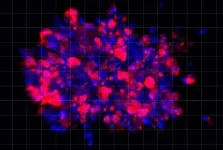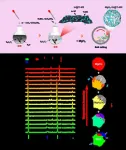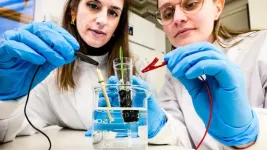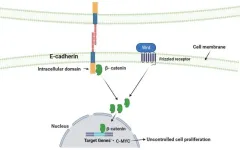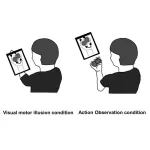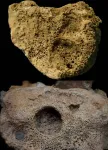(Press-News.org) A drug screening system that models cancers using lab-grown tissues called organoids has helped uncover a promising target for future pancreatic cancer treatments, according to a new study from researchers at Weill Cornell Medicine.
In the study, published Dec. 26 in Cell Stem Cell, the scientists tested more than 6,000 compounds on their pancreatic tumor organoids, which contain a common pancreatic cancer-driving mutation. They identified one compound—an existing heart drug called perhexiline maleate—that powerfully suppresses the organoids’ growth.
The researchers discovered that the cancer-driving mutation in the organoids forces the abnormally high production of cholesterol, which the drug largely reverses.
“Our findings identify hyperactive cholesterol synthesis as a vulnerability that may be targetable in most pancreatic cancers,” said study co-senior author Dr. Todd Evans, vice chair for research in surgery, the Peter I. Pressman MD Professor in Surgery, and a member of the Hartman Institute for Therapeutic Organ Regeneration at Weill Cornell Medicine.
“This study also highlights the value of using genetically well-defined organoids to model cancer and discover new treatment strategies,” said co-senior author Dr. Shuibing Chen, director of the Center for Genomic Health, the Kilts Family Professor Surgery and a member of the Hartman Institute for Therapeutic Organ Regeneration at Weill Cornell Medicine.
The other co-senior author was Dr. Fong Cheng Pan, a research assistant professor in the department of surgery at Weill Cornell Medicine during the study.
The study’s co-first authors were postdoctoral researcher Dr. Xiaohua Duan, instructor Dr. Tuo Zhang, and a visiting fellow, Dr. Lingling Feng, all at Weill Cornell Medicine during the study.
A Tumor Organoid-Based Screening System
Organoids have become popular tools for studying tissues in health and disease. They can be made from human or animal tissue, they can recreate much of an organ’s complex architecture, and they can be genetically engineered for precision modeling. Organoids can also model specific tumor types with their cancer-driving gene mutations. Indeed, when these tumor organoids are derived from human tissue, they have the potential to model human cancers better than any animal model.
In the study, the researchers set up an organoid-based automated drug-screening system for the most common form of pancreatic cancer, pancreatic ductal adenocarcinoma (PDAC)—one of the most untreatable and lethal of cancers. The organoids, made from normal mouse pancreatic tissue, were engineered to contain various sets of mutations known to drive human pancreatic tumors. All the organoids contained KrasG12D, the mouse version of a cancer-driving mutant gene found in most cases of PDAC.
The researchers tested a library of more than 6,000 compounds, including FDA-approved drugs, on the organoids, identifying several that could substantially disrupt their growth. The best of these was perhexiline maleate, an older drug used to treat the heart condition called angina. A modest dose of the drug blocked growth in all the KrasG12D-containing organoids, destroying some of them outright within days, while having no adverse impact on healthy organoids lacking the mutation. The drug had similar effects against mouse and human PDAC-derived tumor organoids transplanted into mice, and in human tumor organoids carrying other types of Kras mutation.
By comparing gene activity patterns in treated and untreated organoids, the researchers found that cancer-associated mutant Kras greatly boosts the production of cholesterol in organoid cells, and that perhexiline maleate opposes this effect by inhibiting a key cholesterol metabolic pathway regulatory factor called SREBP2.
Cholesterol as an Emerging Cancer Target
The discovery of cholesterol’s role was not entirely surprising, since cholesterol is an essential building-block used in making new cells, and a promoter of cell survival; it is already known to be an important sustainer of malignant growth for some other tumors, including lung tumors. Now, the results suggest that targeting it may be an effective new treatment strategy against PDAC.
Perhexiline maleate’s effectiveness in human organoids harboring several different Kras mutations also suggests that turbo-charged cholesterol synthesis can be a general treatment target in KRAS-mutant cancers.
“We hope that our cholesterol-targeting strategy will be independent of particular KRAS mutations and will make it hard for treated tumors to evolve resistance,” said Dr. Evans, who is also a member of the Sandra and Edward Meyer Cancer Center .
Perhexiline maleate is unlikely to be used as-is for treating PDAC. Although it is still prescribed as an angina drug in Australia and some other countries, it can have serious side effects, including liver damage and peripheral nerve damage—which is why it was withdrawn from several European markets in the 1980s, and was never approved in the United States.
“We want a better compound for cancer treatment,” said Dr. Chen. The simplicity of the drug’s chemical structure suggests that it probably can be modified to improve its potency, safety, bloodstream half-life and other properties, she said.
The team now plans to use perhexiline maleate as a starting point for the development of a more refined candidate PDAC drug, and as a laboratory tool for studying cholesterol synthesis in PDAC and other cancers.
Many Weill Cornell Medicine physicians and scientists maintain relationships and collaborate with external organizations to foster scientific innovation and provide expert guidance. The institution makes these disclosures public to ensure transparency. For this information, see the profile for Dr. Shuibing Chen and Dr. Todd Evans.
The research reported in this story was supported in part by the National Institute of Diabetes, Digestive and Kidney Diseases and the National Cancer Institute, both part of the National Institutes of Health, grant numbers R01DK130454, R01DK119667, R01DK119667-02S1, U01 DK127777, R01CA204228. Additional support was provided by the Weill Cornell Medicine Department of Surgery Pancreatic Cancer Initiative and the Tri-Institutional Stem Cell Initiative (Tri-Sci 202005), Department of Surgery, Weill Cornell Medicine.
END
Scientists use organoid model to identify potential new pancreatic cancer treatment
2023-12-26
ELSE PRESS RELEASES FROM THIS DATE:
Risk of young-onset dementia could be reduced through targeting health and lifestyle factors - study
2023-12-26
December 21 Peer reviewed /observational study / in people*
Strictly embargoed 4PM UK time on Tuesday December 26
Researchers have identified a wide range of risk factors for young-onset dementia. The findings challenge the notion that genetics are the sole cause of the condition, laying the groundwork for new prevention strategies.
The largescale study identified 15 risk factors, which are similar to those for late-onset dementia. For the first time, they indicate that it may be possible to reduce the risk of young-onset dementia ...
In situ characterization reveals different dehydrogenation pathways in MgH2
2023-12-26
They published their work on Dec. 20 in Energy Material Advances.
"Economic, efficient, and safe hydrogen storage methods play a crucial role in exploiting hydrogen energy, reducing carbon emissions, and improving the utilization efficiency of renewable clean energies," said paper author Jianxin Zou, professor in National Engineering Research Center of Light Alloys Net Forming & State Key Laboratory of Metal Matrix Composites. "Solid-state hydrogen storage in hydrides has been considered as a promising hydrogen storage technology. Although the industrial ...
Artificial intelligence predicts the influence of microplastics on soil properties
2023-12-26
Plastic waste and its buildup in nature has become a major environmental concern in recent times. While plastic pollution in the oceans is undoubtedly a concern, the presence of plastics in soils around the world is also known to cause severe environmental and health issues. As plastics fragment into smaller pieces known as microplastics (MPs) in the soil through natural and anthropogenic processes, they drastically alter soil properties. Moreover, they are also absorbed by plants, potentially entering human ...
ACP says barriers to participating in the electoral process must be removed
2023-12-25
Embargoed for release until 5:00 p.m. ET on Monday 25 December 2023
Annals of Internal Medicine Tip Sheet
@Annalsofim
Below please find summaries of new articles that will be published in the next issue of Annals of Internal Medicine. The summaries are not intended to substitute for the full articles as a source of information. This information is under strict embargo and by taking it into possession, media representatives are committing to the terms of the embargo not only on their own behalf, but also on behalf of the organization they represent.
----------------------------
1. ...
Electronic “soil” enhances crop growth
2023-12-25
Barley seedlings grow on average 50% more when their root system is stimulated electrically through a new cultivation substrate. In a study published in the journal PNAS, researchers from Linköping University have developed an electrically conductive “soil” for soilless cultivation, known as hydroponics.
“The world population is increasing, and we also have climate change. So it’s clear that we won’t be able to cover the food demands of the planet with only the already existing agricultural methods. But with hydroponics we can grow food also in ...
Unraveling the mystery of hereditary diffuse gastric cancer
2023-12-25
Gastric cancer, a significant global health burden, claims over 7% of cancer-related deaths annually. Although only 1-3% of cases have a genetic basis, understanding these genetic drivers is crucial for developing preventative strategies.
Gastric cancer, a formidable foe in the global health arena, casts a long shadow over millions of lives each year. While its tendrils reach far and wide, a distinct subset – hereditary diffuse gastric cancer (HDGC) – emerges as a particularly aggressive and enigmatic adversary. This group of cancers, accounting for roughly 10% ...
Power of illusion can help with learning new movements
2023-12-23
Tokyo, Japan – Researchers from Tokyo Metropolitan University showed that visual aids which create the illusion of movement, like a screen placed in front of one’s hand showing the hand move, can improve motor performance and the early stages of motor learning. Compared to observing third-person motions, functional near-infrared spectroscopy data also showed greater changes in brain activity in regions associated with motor learning. Findings like this might inform new treatment strategies for hemiplegic stroke patients.
Visual-motor illusion (VMI) is the curious illusion of watching your body move even while it is still. ...
Live Christmas trees affect indoor air chemistry, NIST researchers find
2023-12-22
Every holiday season, Americans buy nearly 30 million live Christmas trees. Many families enjoy not only having a live tree inside their homes but also smelling the fresh fragrance it creates. That smell comes from chemicals called volatile organic compounds (VOCs). However, little is known about how much is emitted and whether they have any health impacts.
“Our nose is a good chemical sensor,” said Dustin Poppendieck, an environmental engineer at the National Institute of Standards and Technology (NIST). “We know that these trees are emitting something, ...
Evolution of tuberculosis – in new light
2023-12-22
Recent research suggests that the emergence of tuberculosis infection in human populations dates back tens of thousands of years earlier than previously known cases in the Middle East. In collaboration with an international research team, Hungarian researchers have edited and published a special issue of the journal Tuberculosis.
In July 2022, the Department of Anthropology of the University of Szeged organised a conference on the paleopathology and evolution of tuberculosis. The ICEPT3 conference was closely linked to the NRDI-best funded research project of György ...
Study reveals the relationship of gut microbiome on children’s brain development and function
2023-12-22
WELLESLEY, MA – Emerging evidence implicates the gut microbiome in cognitive outcomes and neurodevelopmental disorders, but the influence of gut microbial metabolism on typical neurodevelopment has not been explored in detail.
Researchers from Wellesley College, in collaboration with other institutions, have demonstrated that differences in the gut microbiome are associated with overall cognitive function and brain structure in healthy children. This study – published today in Science Advances – is a part of the Environmental Influences ...
